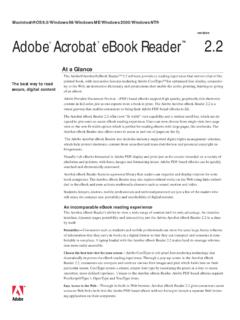Transcription of Spring Framework - Tutorialspoint
1 Spring Framework i About the Tutorial Spring Framework is an open source Java platform that provides comprehensive infrastructure support for developing robust Java applications very easily and very rapidly. Spring Framework was initially written by Rod Johnson and was first released under the Apache license in June 2003. This tutorial has been written based on Spring Framework version released in Mar 2015. Audience This tutorial is designed for Java programmers with a need to understand the Spring Framework in detail along with its architecture and actual usage. This tutorial will bring you at an intermediate level of expertise, from where you can take yourself to higher levels of expertise. Prerequisites Before proceeding with this tutorial, you should have a good understanding of Java programming language. A basic understanding of Eclipse IDE is also required because all the examples have been compiled using Eclipse IDE.
2 Questions and Answers Spring Questions and Answers has been designed with a special intention of helping students and professionals preparing for various Certification Exams and Job Interviews. This section provides a useful collection of sample Interview Questions and Multiple Choice Questions (MCQs) and their answers with appropriate explanations - Study Spring Questions and Answers Disclaimer & Copyright Copyright 2016 by Tutorials Point (I) Pvt. Ltd. All the content and graphics published in this e-book are the property of Tutorials Point (I) Pvt. Ltd. The user of this e-book is prohibited to reuse, retain, copy, distribute or republish any contents or a part of contents of this e-book in any manner without written consent of the publisher. We strive to update the contents of our website and tutorials as timely and as precisely as possible, however, the contents may contain inaccuracies or errors. Tutorials Point (I) Pvt.
3 Ltd. provides no guarantee regarding the accuracy, timeliness or completeness of our website or its contents including this tutorial. If you discover any errors on our website or in this tutorial, please notify us at Spring Framework ii Table of Contents About the Tutorial .. i Audience .. i Prerequisites .. i Questions and Answers .. i Disclaimer & Copyright .. i Table of Contents .. ii 1. Spring OVERVIEW .. 1 Benefits of Using the Spring Framework .. 1 Dependency Injection (DI) .. 2 Aspect Oriented Programming (AOP) .. 2 2. Spring ARCHITECTURE .. 3 Core Container .. 3 Data Access/Integration .. 4 Web .. 4 4 3. Spring ENVIRONMENT SETUP .. 6 Step 1 Set Up Java Development Kit (JDK) .. 6 Step 2 Install Apache Common Logging API .. 6 Step 3 Set Up Eclipse 7 Step 4 Set Up Spring Framework Libraries .. 8 4. Spring HELLO WORLD EXAMPLE .. 10 Step 1 - Create Java Project .. 10 Step 2 - Add Required Libraries .. 11 Step 3 - Create Source Files.
4 13 Spring Framework iii Step 4 - Create Bean Configuration File .. 15 Step 5 - Running the Program .. 16 5. Spring IOC CONTAINERS .. 17 Spring BeanFactory Container .. 18 Spring ApplicationContext Container .. 20 6. Spring BEAN DEFINITION .. 24 Spring Configuration Metadata .. 25 7. Spring BEAN SCOPES .. 27 The Singleton Scope .. 27 The Prototype Scope .. 30 8. Spring BEAN LIFE CYCLE .. 33 Initialization Callbacks .. 33 Destruction Callbacks .. 34 Default Initialization & Destroy Methods .. 37 9. Spring BEAN POST PROCESSORS .. 38 10. Spring BEAN DEFINITION INHERITANCE .. 42 Bean Definition Template .. 46 11. Spring DEPENDENCY INJECTION .. 47 Constructor-based Dependency Injection .. 48 Setter-based Dependency Injection .. 52 12. Spring INJECTING INNER BEANS .. 57 13. Spring INJECTING COLLECTION .. 61 Injecting Bean References .. 65 Injecting Null and Empty String Values .. 67 Spring Framework iv 14. Spring BEANS AUTOWIRING.
5 68 Autowiring Modes .. 68 Autowiring byName .. 69 Autowiring byType .. 72 Autowiring by Constructor .. 76 Limitations with Autowiring .. 79 15. Spring ANNOTATION-BASED CONFIGURATION .. 81 @Required Annotation .. 82 @Autowired Annotation .. 85 @Qualifier Annotation .. 92 JSR-250 Annotations .. 96 16. Spring JAVA-BASED 100 @Configuration & @Bean Annotations .. 100 Injecting Bean Dependencies .. 103 The @Import Annotation .. 106 Lifecycle Callbacks .. 107 Specifying Bean Scope .. 108 17. Spring EVENT HANDLING .. 109 Listening to Context Events .. 110 18. Spring CUSTOM EVENTS .. 114 19. Spring AOP Framework .. 118 AOP Terminologies .. 118 Types of Advice .. 119 Custom Aspects Implementation .. 119 XML Schema-based AOP with Spring .. 119 Spring Framework v XML Schema Based AOP Example .. 123 @AspectJ-based AOP with Spring .. 129 @AspectJ-based AOP Example .. 131 20. Spring JDBC Framework .. 137 JDBC Template Class .. 137 Configuring Data Source.
6 137 Data Access Object (DAO) .. 138 Executing SQL Statements .. 138 Executing DDL Statements .. 140 Spring JDBC Framework Examples .. 140 Spring JDBC Example .. 141 SQL Stored Procedure in Spring .. 148 21. Spring TRANSACTION MANAGEMENT .. 156 Local vs. Global Transactions .. 156 Programmatic vs. Declarative .. 157 Programmatic Transaction 157 Declarative Transaction Management .. 165 Spring Transaction Abstractions .. 174 22. Spring WEB MVC Framework .. 179 The DispatcherServlet .. 179 Required Configuration .. 180 Defining a Controller .. 182 Creating JSP Views .. 183 Spring Web MVC Framework Examples .. 183 Spring MVC Hello World Example .. 184 Spring MVC Form Handling 187 Spring Framework vi Spring Page Redirection Example .. 194 Spring Static Pages Example .. 199 Spring Exception Handling Example .. 204 23. Spring LOGGING WITH 213 Jakarta Commons Logging (JCL) API .. 216 Spring Framework 1 Spring is the most popular application development Framework for enterprise Java.
7 Millions of developers around the world use Spring Framework to create high performing, easily testable, and reusable code. Spring Framework is an open source Java platform. It was initially written by Rod Johnson and was first released under the Apache license in June 2003. Spring is lightweight when it comes to size and transparency. The basic version of Spring Framework is around 2MB. The core features of the Spring Framework can be used in developing any Java application, but there are extensions for building web applications on top of the Java EE platform. Spring Framework targets to make J2EE development easier to use and promotes good programming practices by enabling a POJO-based programming model. Benefits of Using the Spring Framework Following is the list of few of the great benefits of using Spring Framework : Spring enables developers to develop enterprise-class applications using POJOs. The benefit of using only POJOs is that you do not need an EJB container product such as an application server but you have the option of using only a robust servlet container such as Tomcat or some commercial product.
8 Spring is organized in a modular fashion. Even though the number of packages and classes are substantial, you have to worry only about the ones you need and ignore the rest. Spring does not reinvent the wheel, instead it truly makes use of some of the existing technologies like several ORM frameworks, logging frameworks, JEE, Quartz and JDK timers, and other view technologies. Testing an application written with Spring is simple because environment-dependent code is moved into this Framework . Furthermore, by using JavaBean-style POJOs, it becomes easier to use dependency injection for injecting test data. Spring 's web Framework is a well-designed web MVC Framework , which provides a great alternative to web frameworks such as Struts or other over-engineered or less popular web frameworks. Spring provides a convenient API to translate technology-specific exceptions (thrown by JDBC, Hibernate, or JDO, for example) into consistent, unchecked exceptions.
9 Lightweight IoC containers tend to be lightweight, especially when compared to EJB containers, for example. This is beneficial for developing and deploying applications on computers with limited memory and CPU resources. 1. Spring Overview Spring Framework 2 Spring provides a consistent transaction management interface that can scale down to a local transaction (using a single database, for example) and scale up to global transactions (using JTA, for example). Dependency Injection (DI) The technology that Spring is most identified with is the Dependency Injection (DI) flavor of Inversion of Control. The Inversion of Control (IoC) is a general concept, and it can be expressed in many different ways. Dependency Injection is merely one concrete example of Inversion of Control. When writing a complex Java application, application classes should be as independent as possible of other Java classes to increase the possibility to reuse these classes and to test them independently of other classes while unit testing.
10 Dependency Injection helps in gluing these classes together and at the same time keeping them independent. What is dependency injection exactly? Let's look at these two words separately. Here the dependency part translates into an association between two classes. For example, class A is dependent of class B. Now, let's look at the second part, injection. All this means is, class B will get injected into class A by the IoC. Dependency injection can happen in the way of passing parameters to the constructor or by post-construction using setter methods. As Dependency Injection is the heart of Spring Framework , we will explain this concept in a separate chapter with relevant example. Aspect Oriented Programming (AOP) One of the key components of Spring is the Aspect Oriented Programming (AOP) Framework . The functions that span multiple points of an application are called cross-cutting concerns and these cross-cutting concerns are conceptually separate from the application's business logic.


















